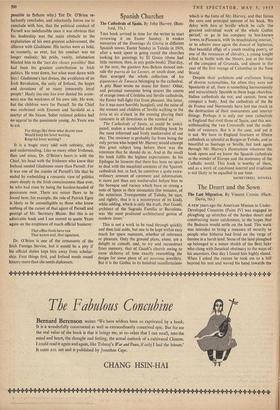Spanish Churches
THIS book arrived in time for the writer to start reviewing it on Easter Sunday. It evokes memories of the Domingo da Gloria in different Spanish towns. Easter Sunday in Toledo iri 1919, after a week spent in going round the churches looking for paintings by El Greco (those had little mention, then, in any guide-book). That day, or the next, the giantess Ana-Bolena danced out- side the puerto de los Leones, or south door, and then emerged the whole collection of los gigantones de Tarasca belonging to the cathedral. A pity Bizet wrote no music for them! Other, and personal memories bring nearer the courts of orange trees of Cordoba and Seville cathedrals, the Easter bull-fight (far from pleasant, this latter, for it was most horribly bungled), and the noise of the women and children of Seville walking to the feria at six o'clock in the evening playing their castanets in all directions in the scented air.
The Cathedrals of Spain,• as could be antici- pated, makes a wonderful and thrilling book by the most informed and lively mediaevalist of our day. The reviewer is probably far from being the only person who hoped Mr. Harvey would attempt this great subject long before there was the intention that he should do so. And in the result his book fulfils the highest expectations. In his Epilogue he laments that there has been no space to deal with the manifold contents of the Spanish cathedrals but, in fact, he contrives a quite extra- ordinary amount of comment and information, is more just than any mediaevalist before him to the baroque and rococo which have so strong a note of Spain in their intonation (for instance, of the notorious Transparente of Toledo, he says,
and rightly, that it is a masterpiece of its kind), while adding, which is only the truth, that Gaudi, architect of the Sagrada Familia at Barcelona, was 'the most profound architectural genius of modern times.'
This is not a work to be read through quickly and then laid aside, but one to be kept within easy reach for spare moments, whether of reference or pleasure. Only the ground plans, alone, are a delight to consult, and, to try and reconstruct from memory, that of Gaudf's church owing to some alchemy of time exactly resembling the design for some piece of art nouveau jewellery. But it is the Gothic in its hundred manifestations
which is the forte of Mr. Harvey, and that forms the core and principal interest of his book. We
delay with him at Seville which he calls 'the greatest individual work of the whole Gothic period,' or go in his company to less-known towns, to Plasencia, with 'its breathtaking interior,' or to admire once again the doncel of Sigiienza, that beautiful effigy of a youth reading poetry, or one of the romances of chivalry, a young knight killed in battle with the Moors, just at the time of the conquest of Granada, and almost in the year of the first voyage of Columbus to the New World.
Despite their architects and craftsmen being of diverse nationalities, for often they were not Spaniards at all, there is something harmoniously and miraculously Spanish in these huge churches. Italian cathedrals do not, and cannot, form so compact a body. And the cathedrals of the lle de France and Normandy have lost too much in the destruction of their monuments and interior fittings. Perhaps it is only our own cathedrals in England that rival those of Spain, and this not- withstanding the two Cromwells and the multi- tude of restorers. But it is the case, and yet it is not. We have in England fourteen or fifteen cathedrals as splendid as Burgos or Toledo, and as . beautiful as Santiago or Seville, but look again through Mr. Harvey's illustrations wherever the book opens and we know the Spanish cathedrals as the wonder of Europe and the testimony of the Catholic world. This book is worthy of them, and as a work of combined interest and erudition is not likely to be equalled in our time.
SACHEVERELL SITWELL










































 Previous page
Previous page